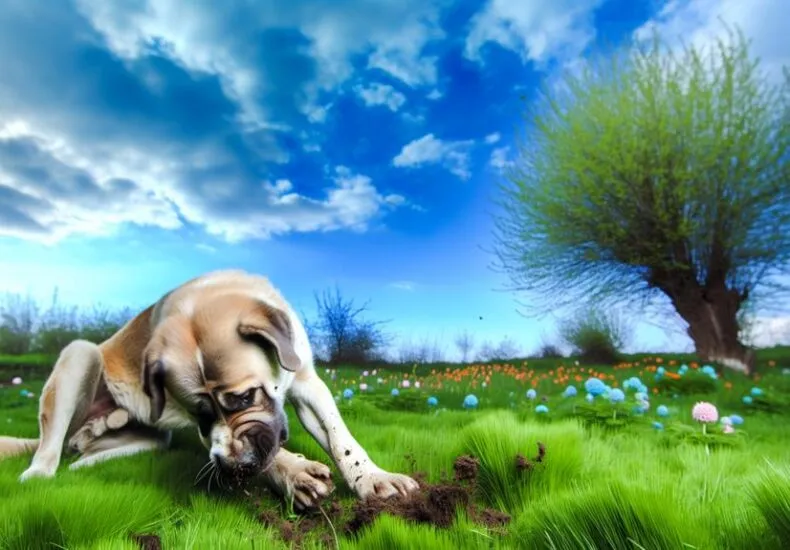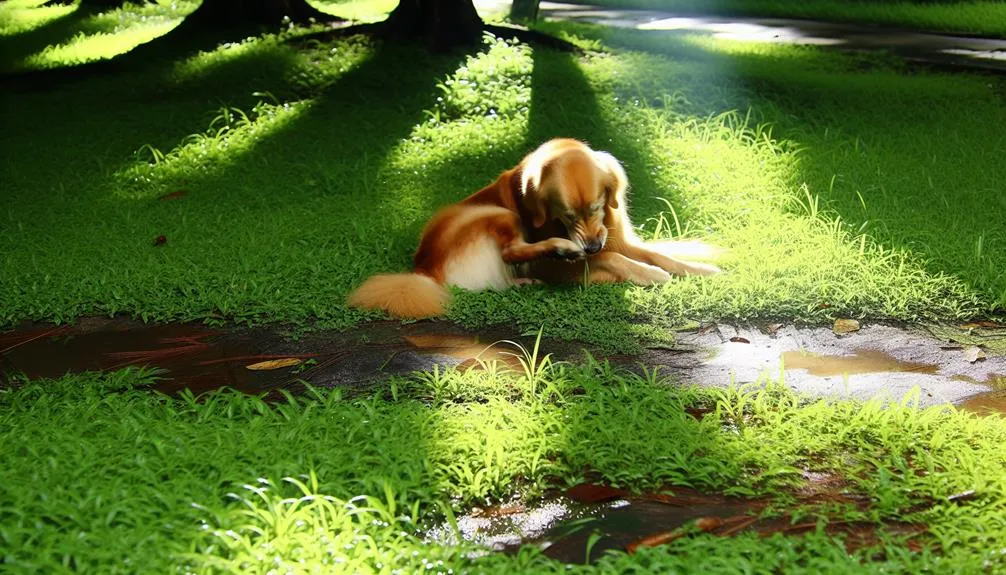
Why Dogs Scratch the Grass
Did you know that nearly 80% of dog owners observe their pets scratching the grass at least once a week? This seemingly simple behavior can actually reveal a range of instinctual motivations that might surprise you. From marking territory to seeking comfort, dogs have their reasons, and understanding these can enhance your relationship with your pet. What might seem like a trivial action often carries deeper significance, hinting at their evolutionary past and emotional state. So, what exactly drives this behavior, and how can it impact your dog's well-being?
Instinctual Behavior From Ancestors
Dogs scratching the grass can be traced back to instinctual behaviors inherited from their wild ancestors. These actions are rooted in ancestral habits that reflect evolutionary traits developed over millennia. In the wild, dogs' foraging behaviors often required them to dig and scratch at the ground to uncover food sources, such as rodents or roots. This survival instinct is deeply embedded in their genetic makeup, prompting similar behaviors in domesticated dogs when they interact with their environment.
When you observe your dog scratching the grass, it's not merely a playful act; it's also a form of territory assessment. By creating a disturbance, dogs can detect scents left by other animals, providing critical information about their surroundings. This environmental interaction is essential for their understanding of the world, akin to how their ancestors would have explored their territories.
Additionally, scratching can serve as a grooming ritual. In the wild, dogs would often scratch to remove debris or parasites from their fur, contributing to their overall health. The act of scratching may also facilitate social bonding, as dogs often engage in similar behaviors with one another, reinforcing group dynamics.
In essence, while your dog may seem to be indulging in a simple act of scratching, it's actually an intricate display of instinctual behavior that harkens back to their wild roots. Understanding these behaviors sheds light on the complexity of canine nature and highlights the strong influence of their evolutionary background on their current actions.
Marking Territory
A common behavior observed in dogs when they scratch the grass is related to marking territory. This action serves multiple functions, primarily associated with territorial behavior. When your dog scratches the ground, it's often a dominance display aimed at asserting its presence in an area. This marking ritual not only establishes boundaries but also communicates social hierarchy among canines.
Dogs possess scent glands in their paws, and by scratching, they release pheromones that contribute to scent differentiation, allowing other dogs to gather information about their presence. This environmental awareness is vital for dogs, as it helps them navigate social interactions and potential rivalries. When your dog marks a specific spot, it's fundamentally claiming that territory, which can be a form of resource guarding, especially in areas frequented by other dogs.
Moreover, the act of scratching may trigger a series of social cues that inform nearby dogs of your pet's status and intentions. This behavior extends beyond mere marking; it's a complex communication tool that reflects a dog's understanding of its environment and social relationships. By engaging in these marking rituals, your dog is not just asserting dominance but also participating in a broader network of canine communication, reinforcing its place within the local social hierarchy. Understanding this aspect of your dog's behavior can enhance your bond and improve your ability to manage interactions in multi-dog environments.
Comfort and Nesting

One key reason for scratching the grass involves creating comfort and nesting areas. When your dog engages in this behavior, it's often a reflection of instinctual nesting behavior inherited from their wild ancestors. By scratching, dogs can manipulate their environment to form a comfortable resting spot. This action can involve moving debris, creating a small depression, or simply flattening the grass to enhance their resting area.
The act of scratching not only makes the surface more comfortable but can also help regulate temperature. Dogs may scratch the ground to uncover cooler earth during hot weather or to create a more insulated area during colder months. This behavior is essential for ensuring dog comfort, especially when they're preparing to rest or sleep.
In addition to temperature regulation, scratching can serve a psychological purpose. It allows your dog to feel more secure in their chosen spot, reinforcing a sense of territory and safety. The act of creating a nest-like environment helps dogs feel protected, which is particularly important for those who may be anxious or uncomfortable in unfamiliar surroundings.
Exploring Scents
When your dog scratches the grass, they engage in scent marking behavior that's integral to their communication. This instinctual action allows them to leave their scent and gather information about other animals in the area. Understanding this behavior helps you appreciate the complex ways dogs interact with their environment.
Scent Marking Behavior
Although dogs may seem playful as they scratch at the grass, this behavior often serves a crucial purpose related to scent marking. When your dog scratches the ground, it activates scent receptors in their paws, dispersing pheromones into the environment. This olfactory communication is essential for establishing territory hierarchy and social bonding among canines.
By creating scent trails, your dog signals their presence to others, conveying behavioral signals that may indicate dominance, availability, or territorial boundaries. This process is not merely instinctive; it reflects a sophisticated understanding of their surroundings, enhancing their environmental awareness.
Through pheromone exchange, dogs can gather information about other animals, including their reproductive status and health. This intricate form of communication allows them to navigate their social world effectively.
As your dog engages in this behavior, they're not just playing; they're actively participating in a complex network of social interactions. Understanding this aspect of scent marking enriches your appreciation of how dogs communicate and connect with their environment and each other. By recognizing these behaviors, you'll gain insight into your dog's social life and instincts.
Natural Instincts at Play
Dogs' instinct to scratch the grass goes beyond mere scent marking; it also plays a significant role in exploring their environment through various scents. This digging behavior allows dogs to interact with their surroundings, uncovering information about other animals and potential food sources. Different grass patterns can indicate the presence of other creatures, and dogs can sense these variations.
Here are three key factors that explain why your dog scratches the grass:
- Scent Exploration: When dogs dig or scratch, they release scents trapped in the soil, enhancing their olfactory experience.
- Environmental Awareness: Scratching can reveal hidden scents from other animals, helping dogs assess the area for potential threats or companions.
- Instinctual Behavior: This behavior is rooted in their ancestry, where scratching would help dogs uncover scents of prey or find a suitable resting spot.
Understanding these aspects of your dog's behavior can deepen your appreciation for their natural instincts. By scratching at grass, your dog is not only marking territory but also engaging in a complex interaction with its environment, driven by instinctual needs for exploration and awareness.
Communication Through Scents
The act of scratching grass serves as a vital communication method for dogs, primarily through the release and detection of scents. When your dog scratches the ground, it disperses pheromones and other chemical signals into the environment. These scents play a significant role in scent communication, allowing dogs to convey information about their presence, reproductive status, and even their emotional state.
By scratching, your dog also uncovers scents buried in the soil, which can provide insights into the activities of other animals in the area. This behavior signaling is essential for social interactions, helping dogs to establish territory and assess potential threats or opportunities. The grass acts as a medium, enhancing the olfactory landscape that your dog navigates.
Moreover, scent communication can influence a dog's behavior. For instance, a dog may become more excited or cautious based on the scents it encounters during its scratching ritual. Understanding this aspect of your dog's behavior can deepen your appreciation for their complex communication methods, emphasizing the importance of olfactory cues in their interactions with both the environment and other dogs.
Cooling Down

When dogs scratch the grass, they're often engaging in a behavior that aids in natural temperature regulation. The act of disturbing the turf can expose cooler soil or create a more comfortable spot to lie down. This behavior serves as a way for your dog to manage heat and find relief from rising body temperatures.
Natural Temperature Regulation
While many might associate dogs scratching the grass with playful behavior, it also serves an important purpose in natural temperature regulation. Canine behavior often includes this scratching as a means to help control body temperature, especially on warm days. When dogs scratch the grass, they may be trying to create a cooler surface to lie down on or to expose cooler soil beneath the surface.
Here are three key ways this behavior supports temperature control:
- Air Circulation: Scratching allows for increased airflow around the dog's body, helping to dissipate heat more effectively.
- Soil Temperature: The ground can be notably cooler than the surrounding air. By scratching, dogs can access this cooler layer, providing relief from heat.
- Behavioral Instinct: This action is often instinctual, harking back to their wild ancestors who would scratch to create a more comfortable resting spot in hot environments.
Understanding this aspect of canine behavior reveals how important temperature regulation is to a dog's overall well-being, allowing them to stay cool and comfortable in varying environmental conditions.
Turf as Insulation
How does turf function as insulation for dogs seeking relief from heat? Turf offers significant insulation properties that help in cooling down your dog during hot weather. Its structure and composition allow it to absorb heat, creating a more temperate environment for your pet. The grass blades provide a cooler surface compared to asphalt or concrete, making them ideal for your dog to rest on.
| Turf Benefits | Insulation Properties | Effects on Dogs |
|---|---|---|
| Reduces heat absorption | Maintains lower surface temperature | Provides comfort and relief |
| Soft and cushioned surface | Minimizes ground heat transfer | Encourages relaxation and resting |
| Natural cooling effect | Enhances air circulation | Promotes hydration and cooling behavior |
Playing and Socializing
Playing and socializing are essential aspects of a dog's life, influencing both their physical health and emotional well-being. Engaging in fetch games, group activities, and outdoor fun not only provides exercise but also fosters social bonding. Regular playtime enhances canine interactions and encourages playful behavior, which is crucial for a dog's overall development.
Consider the following playtime benefits:
- Physical Health: Exercise routines, including fetch games, help maintain a healthy weight and improve cardiovascular health. Active play reduces the risk of obesity and related health issues.
- Social Skills: Dog parks serve as excellent environments for enrichment opportunities, allowing your dog to interact with other dogs. These interactions can teach important social cues and appropriate behaviors.
- Mental Stimulation: Engaging in varied activities, such as agility courses or interactive toys, provides cognitive challenges and prevents boredom. This mental stimulation is essential for a dog's emotional well-being.
Relieving Stress and Anxiety

Many dogs exhibit behaviors like scratching the grass as a means of relieving stress and anxiety. This behavior serves as a behavioral outlet, allowing dogs to engage in instinctive coping mechanisms. When your dog scratches the grass, it often seeks emotional release, providing both physical activity and mental stimulation. This action can act as a calming ritual, helping to mitigate feelings of distress.
| Behavior | Purpose |
|---|---|
| Scratching the Grass | Stress relief and anxiety reduction |
| Digging | Environmental interaction |
| Sniffing | Sensory engagement |
| Running | Physical activity |
Through scratching, dogs interact with their environment, which can promote anxiety reduction. The act of engaging with the grass can heighten their sensory experience, allowing for an emotional outlet that can be beneficial for their mental health. This instinctive behavior is particularly noticeable in situations where dogs may feel overwhelmed or anxious, such as during thunderstorms or when new people visit.
Frequently Asked Questions
Do All Dog Breeds Scratch the Grass Similarly?
Not all dog breeds scratch the grass similarly. Each breed exhibits unique behaviors influenced by their individual tendencies, which can affect how they interact with their environment, including scratching behaviors related to instinct or comfort.
Can Scratching Grass Indicate a Health Issue?
Could your dog's grass scratching be more than just a quirky habit? It can indicate potential health concerns. Observing behavioral signs alongside this action may help you identify whether a visit to the vet is necessary.
How Can I Discourage My Dog From Scratching Grass?
To discourage your dog from scratching grass, employ training techniques like redirecting their focus and rewarding alternative behaviors. Behavioral modification strategies can help reinforce desired actions, ensuring a more controlled and satisfying outdoor experience for both of you.
Is Scratching Grass More Common in Certain Seasons?
You'll notice that grass scratching can be more prevalent during certain seasons. This seasonal behavior often peaks in spring and summer, as dogs engage more with their environment, drawn to scents and textures available in grass.
Does Scratching Grass Serve Any Purpose for Puppies?
Scratching grass in puppies often reflects playful behavior and natural instincts. This action can help them explore their environment, communicate with other dogs, and even relieve stress, contributing to their overall development and well-being.
Conclusion
To sum up, your dog's grass-scratching behavior is deeply rooted in instinct and serves multiple purposes. While some might joke that they're just trying to "dig to China," the truth is this behavior helps them mark territory, create comfort, and explore their environment. So next time you see your dog scratching away, remember it's not just play; it's a complex interaction with their instincts, emotions, and the world around them. Understanding this can deepen your bond with your furry friend.
You may also like
Archives
Calendar
| M | T | W | T | F | S | S |
|---|---|---|---|---|---|---|
| 1 | 2 | 3 | 4 | 5 | 6 | |
| 7 | 8 | 9 | 10 | 11 | 12 | 13 |
| 14 | 15 | 16 | 17 | 18 | 19 | 20 |
| 21 | 22 | 23 | 24 | 25 | 26 | 27 |
| 28 | 29 | 30 | ||||
Leave a Reply